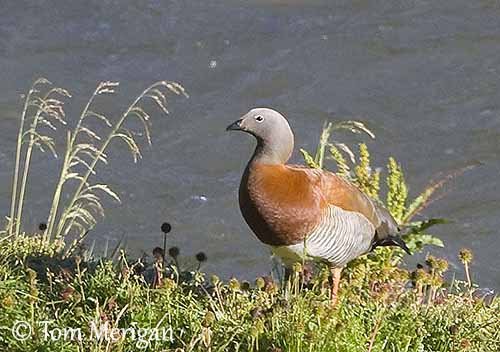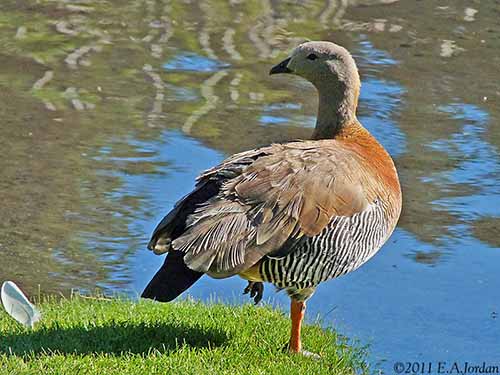
Fr: Ouette à tête grise
All: Graukopfgans
Esp: Cauquén Cabecigrís – Canquén - Cauquén real
Ita: Oca testacenerina
Nd: Grijskopgans
Sd: Gråhuvad gås
Photographers:
Eduardo Andrés Jordan
MIS AVES – AVES DE ARGENTINA
Tom Merigan
Tom Merigan’s Photo Galleries
Text by Nicole Bouglouan
Sources:
HANDBOOK OF THE BIRDS OF THE WORLD vol 1 by Josep del Hoyo-Andrew Elliot-Jordi Sargatal - Lynx Edicions - ISBN: 8487334105
GUIDE DES CANARDS, DES OIES ET DES CYGNES – de Steve Madge - Delachaux et Niestlé - ISBN: 2603013769
BirdLife International (BirdLife International)
Birding Patagonia – Adventure expeditions
Ashy-headed Goose
Chloephaga poliocephala
Anseriformes Order – Anatidae Family
INTRODUCTION:
The Ashy-headed Goose is one of the five species of genus Chloephaga which included the South American endemic geese. This goose occurs in Patagonia and Tierra del Fuego, from where it sporadically reaches the Falkland Islands. This species breeds in mountainous areas and winters on lowlands.
DESCRIPTION OF THE BIRD:
Biometrics:
Length: 50-60 cm
Weight: 2200 g
The adult has ashy-grey head and neck. Mantle, upper back, neck base and breast are bright reddish, sometimes with fine black barring, but this feature varies according to each bird. The lower back is blackish. Uppertail-coverts and tail are black with green sheen.
On the upperwing, scapulars and tertials are greyish-chestnut. Lesser and median wing-coverts are pale yellowish. We can see a bright metallic green speculum formed by the greater wing-coverts. The primaries are black with greenish gloss. The secondaries are pale yellow.
On the underparts, the breast is bright reddish. The belly is yellowish-white. The flanks are white with chestnut wash and black barring. The undertail-coverts are reddish. Underwing-coverts and axillaries are yellowish-white.
The bill is black. The eyes are dark brown, surrounded by white eyering. The legs are orange on tarsus, but the anterior part is black like the webbed feet.

Both sexes are similar with slightly smaller female.
The juvenile resembles adults, but with duller, mostly brownish-grey head and neck. The upperparts are brownish and barred black. The speculum is dull dark brown.
RANGE:
The Ashy-headed Goose occurs in S Chile and S Argentina to Tierra del Fuego. It can reach sometimes the Falkland Islands.
HABITAT:
The Ashy-headed Goose usually breeds in temperate grasslands, damp forest clearings on high ground and islands, coastal freshwater lakes, swamps and marshes.
Outside the breeding season, it can be found in more open habitats and it uses pastures, meadows and cultivated areas.
This species can be seen from sea-level up to 1500 metres of elevation.
CALLS AND SONGS: SOUNDS BY XENO-CANTO
The Ashy-headed Goose male utters soft whistles whereas the female produces harsh cackling notes.
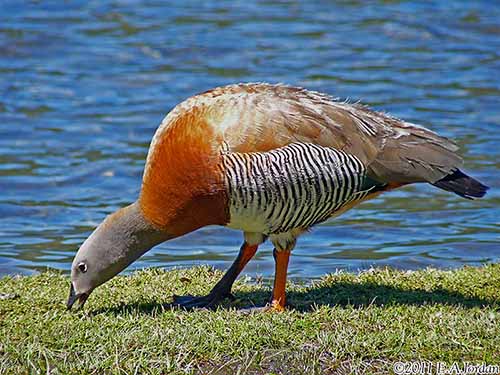
BEHAVIOUR IN THE WILD:
The Ashy-headed Goose is mainly vegetarian and feeds on leaves, stems and seed heads of grasses and sedges.
On the wintering grounds, it favours mainly wheat, maize, sunflower and sorghum stubbles.
It feeds by grazing on the ground, like all Anatidae species.
They are monogamous and pair for life. During the breeding season, they occur in pairs, although outside this period, they may form mixed-flocks with the Upland Goose and the Ruddy-headed Goose. They congregate in large flocks for roosting, usually near lakes, rivers and ponds in woodlands.
At the beginning of the breeding season, the males often chase each other, and noisy disputes occur. The nest-site is chosen as soon as the pair is formed and isolated from the flock.
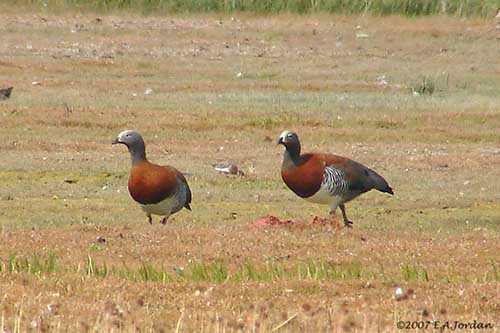
The Ashy-headed Goose is partially migratory. After the breeding season, it migrates N to winter in the south of the provinces of Buenos Aires and Mendoza in Argentina. It reaches sometimes the Falkland Islands, often between September and March, and occasionally breeds there. It may be resident in West Falklands.
The flight is powerful with rapid and continuous wingbeats.
REPRODUCTION OF THIS SPECIES:
The breeding season takes place between November and March in Tierra del Fuego.
The Ashy-headed Goose may nest in isolated pair or in loose groups.
The nest-site is close to the water where trees are present. The nest can be on the ground at base of tree, or in a hole in log, and sometimes fairly high above the ground, between 1,5 and 4 metres. The inner part of the nest is lined with grasses, covered with a second thick lining of down.
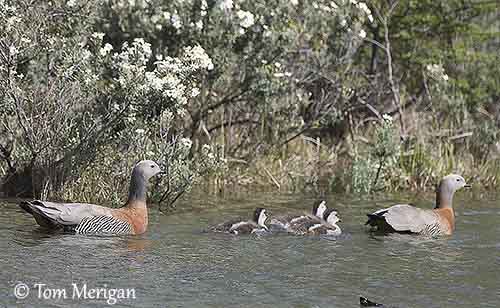
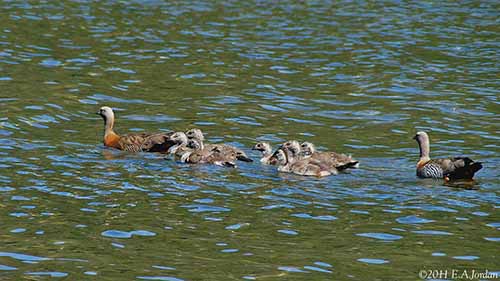
The female lays 4-6 creamy-white to pale brown eggs. She incubates alone during one month while the male guards her.
At hatching, the chicks have greyish to brownish down with darker markings, black bill and legs. They are precocial and leave the nest very soon after hatching. They follow their parents until they fledge, 60-80 days after hatching.

PROTECTION / THREATS / STATUS:
The Ashy-headed Goose has large range but the population is suspected to be decreasing. This species is common in Chile, but rarer in the rest of the range. It is scarce in Tierra del Fuego and rare in Falkland Islands. The population is unknown.
But currently, the Ashy-headed Goose is evaluated as Least Concern.
